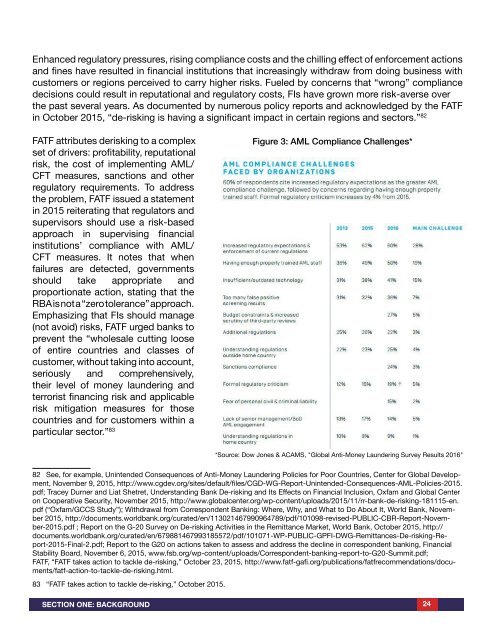FINANCIAL ACCESS
CSNreport17
CSNreport17
Create successful ePaper yourself
Turn your PDF publications into a flip-book with our unique Google optimized e-Paper software.
Enhanced regulatory pressures, rising compliance costs and the chilling effect of enforcement actions<br />
and fines have resulted in financial institutions that increasingly withdraw from doing business with<br />
customers or regions perceived to carry higher risks. Fueled by concerns that “wrong” compliance<br />
decisions could result in reputational and regulatory costs, FIs have grown more risk-averse over<br />
the past several years. As documented by numerous policy reports and acknowledged by the FATF<br />
in October 2015, “de-risking is having a significant impact in certain regions and sectors.” 82<br />
FATF attributes derisking to a complex<br />
set of drivers: profitability, reputational<br />
risk, the cost of implementing AML/<br />
CFT measures, sanctions and other<br />
regulatory requirements. To address<br />
the problem, FATF issued a statement<br />
in 2015 reiterating that regulators and<br />
supervisors should use a risk-based<br />
approach in supervising financial<br />
institutions’ compliance with AML/<br />
CFT measures. It notes that when<br />
failures are detected, governments<br />
should take appropriate and<br />
proportionate action, stating that the<br />
RBA is not a “zero tolerance” approach.<br />
Emphasizing that FIs should manage<br />
(not avoid) risks, FATF urged banks to<br />
prevent the “wholesale cutting loose<br />
of entire countries and classes of<br />
customer, without taking into account,<br />
seriously and comprehensively,<br />
their level of money laundering and<br />
terrorist financing risk and applicable<br />
risk mitigation measures for those<br />
countries and for customers within a<br />
particular sector.” 83<br />
Figure 3: AML Compliance Challenges*<br />
*Source: Dow Jones & ACAMS, "Global Anti-Money Laundering Survey Results 2016"<br />
82 See, for example, Unintended Consequences of Anti-Money Laundering Policies for Poor Countries, Center for Global Development,<br />
November 9, 2015, http://www.cgdev.org/sites/default/files/CGD-WG-Report-Unintended-Consequences-AML-Policies-2015.<br />
pdf; Tracey Durner and Liat Shetret, Understanding Bank De-risking and Its Effects on Financial Inclusion, Oxfam and Global Center<br />
on Cooperative Security, November 2015, http://www.globalcenter.org/wp-content/uploads/2015/11/rr-bank-de-risking-181115-en.<br />
pdf (“Oxfam/GCCS Study”); Withdrawal from Correspondent Banking: Where, Why, and What to Do About It, World Bank, November<br />
2015, http://documents.worldbank.org/curated/en/113021467990964789/pdf/101098-revised-PUBLIC-CBR-Report-November-2015.pdf<br />
; Report on the G-20 Survey on De-risking Activities in the Remittance Market, World Bank, October 2015, http://<br />
documents.worldbank.org/curated/en/679881467993185572/pdf/101071-WP-PUBLIC-GPFI-DWG-Remittances-De-risking-Report-2015-Final-2.pdf;<br />
Report to the G20 on actions taken to assess and address the decline in correspondent banking, Financial<br />
Stability Board, November 6, 2015, www.fsb.org/wp-content/uploads/Correspondent-banking-report-to-G20-Summit.pdf;<br />
FATF, “FATF takes action to tackle de-risking,” October 23, 2015, http://www.fatf-gafi.org/publications/fatfrecommendations/documents/fatf-action-to-tackle-de-risking.html.<br />
83 “FATF takes action to tackle de-risking,” October 2015.<br />
SECTION ONE: BACKGROUND 24


